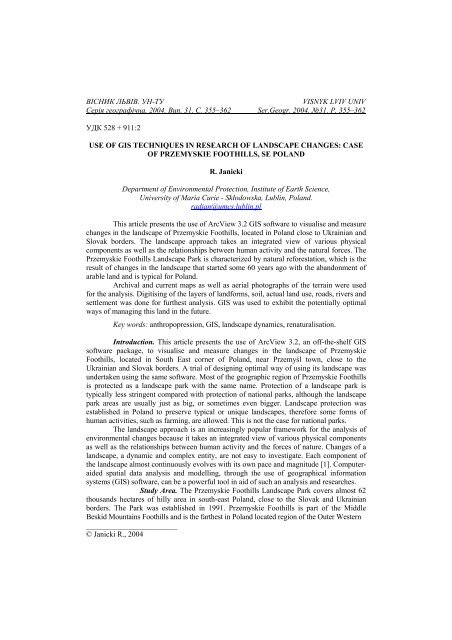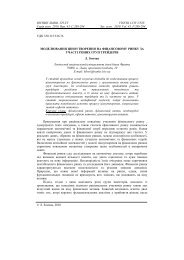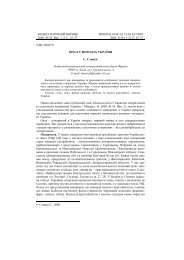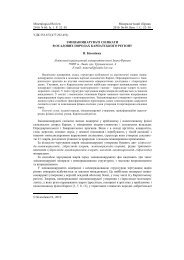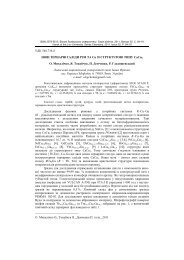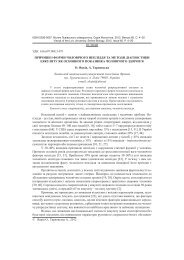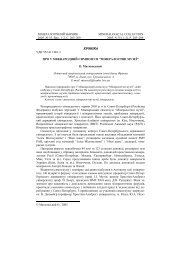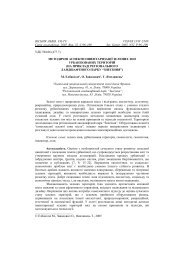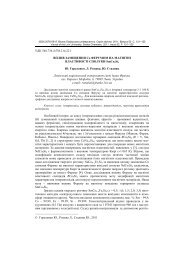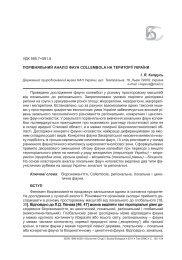Radosław Janicki - EVRICA
Radosław Janicki - EVRICA
Radosław Janicki - EVRICA
Create successful ePaper yourself
Turn your PDF publications into a flip-book with our unique Google optimized e-Paper software.
ВІСНИК ЛЬВІВ. УН-ТУ VISNYK LVIV UNIV<br />
Серія географічна. 2004. Вип. 31. С. 355–362 Ser.Geogr. 2004. №31. Р. 355–362<br />
УДК 528 + 911:2<br />
USE OF GIS TECHNIQUES IN RESEARCH OF LANDSCAPE CHANGES: CASE<br />
OF PRZEMYSKIE FOOTHILLS, SE POLAND<br />
R. <strong>Janicki</strong><br />
Department of Environmental Protection, Institute of Earth Science,<br />
University of Maria Curie - Skłodowska, Lublin, Poland.<br />
radjan@umcs.lublin.pl<br />
This article presents the use of ArcView 3.2 GIS software to visualise and measure<br />
changes in the landscape of Przemyskie Foothills, located in Poland close to Ukrainian and<br />
Slovak borders. The landscape approach takes an integrated view of various physical<br />
components as well as the relationships between human activity and the natural forces. The<br />
Przemyskie Foothills Landscape Park is characterized by natural reforestation, which is the<br />
result of changes in the landscape that started some 60 years ago with the abandonment of<br />
arable land and is typical for Poland.<br />
Archival and current maps as well as aerial photographs of the terrain were used<br />
for the analysis. Digitising of the layers of landforms, soil, actual land use, roads, rivers and<br />
settlement was done for furthest analysis. GIS was used to exhibit the potentially optimal<br />
ways of managing this land in the future.<br />
Key words: anthropopression, GIS, landscape dynamics, renaturalisation.<br />
Introduction. This article presents the use of ArcView 3.2, an off-the-shelf GIS<br />
software package, to visualise and measure changes in the landscape of Przemyskie<br />
Foothills, located in South East corner of Poland, near Przemyśl town, close to the<br />
Ukrainian and Slovak borders. A trial of designing optimal way of using its landscape was<br />
undertaken using the same software. Most of the geographic region of Przemyskie Foothills<br />
is protected as a landscape park with the same name. Protection of a landscape park is<br />
typically less stringent compared with protection of national parks, although the landscape<br />
park areas are usually just as big, or sometimes even bigger. Landscape protection was<br />
established in Poland to preserve typical or unique landscapes, therefore some forms of<br />
human activities, such as farming, are allowed. This is not the case for national parks.<br />
The landscape approach is an increasingly popular framework for the analysis of<br />
environmental changes because it takes an integrated view of various physical components<br />
as well as the relationships between human activity and the forces of nature. Changes of a<br />
landscape, a dynamic and complex entity, are not easy to investigate. Each component of<br />
the landscape almost continuously evolves with its own pace and magnitude [1]. Computeraided<br />
spatial data analysis and modelling, through the use of geographical information<br />
systems (GIS) software, can be a powerful tool in aid of such an analysis and researches.<br />
Study Area. The Przemyskie Foothills Landscape Park covers almost 62<br />
thousands hectares of hilly area in south-east Poland, close to the Slovak and Ukrainian<br />
borders. The Park was established in 1991. Przemyskie Foothills is part of the Middle<br />
Beskid Mountains Foothills and is the farthest in Poland located region of the Outer Western<br />
________________________<br />
© <strong>Janicki</strong> R., 2004
356 R. <strong>Janicki</strong><br />
Carpathian Mountains [6]. The relief of this area is created by wide hills, as high as 350 –<br />
550 m a.s.l., cut as deep as 150 – 200 meters by network of river valleys. It has the<br />
character of ridge-and-valley hills, rather unique in the scale of Poland [4]. Rich brown and<br />
luvisol (lessive) soils were developed on silky or loamy material here [11]. The water and<br />
climate conditions allow the production of a variety of crops, therefore people preferred to<br />
settle down in this area since the early ages.<br />
The first people already appeared in this area at the end of upper Palaeolith. The<br />
Przemyśl region was one of the most densely populated places in Poland ever since the<br />
country’s founding in the year 996 [10]. Human impact on nature grew, along with the<br />
increase of population and was manifested mainly by deforestation. Land clearing was<br />
accompanied by the erosion of soils, followed by the accumulation of alluvia that took<br />
place in local valleys in the XI – XII centuries [5]. The general trend of population increase<br />
is noticeable up to the years of World War II. Population density then was a lot higher<br />
compared with the level that prevailed in the 1930s (100 – 120 people per 1km 2 ). War and<br />
the following military action „Wisła” however, caused a rapid decrease in population. Mass<br />
shooting and arresting of people as well as their forced migration to Germany took place<br />
starting from the first days of war. In total, over 27 thousand of people from Przemyśl<br />
County became unpaid labour in Germany, which comprised 12,5% of all people of the<br />
region [8, 9]. When the Red Army liberated this land from the Germans in summer 1944,<br />
new borders between Poland and Ukrainian Republic of Soviet Union was founded in the<br />
eastern vicinity of Przemyskie Foothills. It was followed by mass resettlement of<br />
Ukrainians from Poland to the east and Poles from USSR to the west. Military action under<br />
cryptonym „Wisła” was started by the Polish government in 1947. As a result, Ukrainians<br />
were resettled either to the USSR or northern and western Poland. In SE Poland where<br />
„Wisła” was executed, as much as 7000 Ukrainians and 2200 Poles lost their lives. 63 854<br />
people were resettled from Przemyśl County [12]. Many villages were burned to the ground<br />
and never rebuilt. Some Poles came here in the forties and fifties, but they could not<br />
compensate the decline in Ukrainians, so the density of population dramatically decreased<br />
to the level of 30 – 40 people per 1km 2 . Ever since the 1950s, the rate of population growth<br />
in this terrain has been very slow. Current trends of Polish demography do not point to any<br />
significant increases in the future. The opposite is more likely. Those dramatic changes in<br />
population levels and decline in anthropopression have strong influence on the landscape of<br />
Przemyskie Foothills. As much as third part of arable land was abandoned and one can<br />
observe there the renaturalisation of the landscape for 60 years already. The term<br />
„renaturalisation” is used here to describe the natural process of landscape succession.<br />
Decline in the anthropogenic change factor, results in the spontaneous return of landscape<br />
to its more natural state. The author finds it hard to find a more adequate term for name this<br />
process than „renaturalisation” of landscape.<br />
Research methods. The research method was complex and required the analysis of<br />
archival and present day maps as well as aerial photographs. Due to the lack of most recent<br />
cartographic materials, field investigations were undertaken with the aim to update the most<br />
recently released map.<br />
The Austro – Hungarian Empire between 1772 and 1918, occupied the southern<br />
part of Poland. This occupied terrain was named „Galicia” (Galizien in German or Galicja<br />
in Polish). The occupants introduced modern administration to this land. Thanks to them,<br />
one of the first censuses was conducted. Most of them were designed for military use, so<br />
they concerned mostly young men. In 1784, the Austrians also reformed the conduct of<br />
church statistics, which made surveying easier and faster and therefore made results more<br />
reliable [2]. Those statistical data were used to complement this research. Austrians were
USE OF GIS TECHNIQUES IN RESEARCH OF LANDSCAPE CHANGES ... 357<br />
also the authors of the first highly detailed maps of South Poland in small scale. Although<br />
there are older maps of Przemyskie Foothills, they are hardly useful for landscape research<br />
due to their large scale and unreliable content.<br />
In the years 1772 – 76, the survey of Galicia took place, which resulted in a map<br />
being made in 1:72 000 scale. This map was then reduced to the scale 1:288 000 and<br />
published in 1790 as „Koenigreich Galizien und Lodomerien”. In 1824 the same map was<br />
published again, after updating its contents. It was the oldest map used in this research.<br />
Although map was generally useful, results of its analysis are unfortunately imprecise<br />
because of the difficulties in defining areas due to inaccuracy and scale. The second map<br />
(Spezialkarte, K. u. K Militär-geographisches Instytut) that was used is from circa 1912 and<br />
also far from perfection. This Austrian map, however, has a more suitable scale for<br />
landscape research – 1:75 000. Inexactness of this map comes from the fact that borders of<br />
forested areas are hard to define. This monochromatic map shows relief in an old fashioned<br />
way. Instead of contour lines authors used shadowing, which makes it very hard to find<br />
borders of forests, since both things were shown in the same colour. The map that can be<br />
considered modern, is a coloured one from the years 1936-39 printed in 1:100 000 scale by<br />
the Polish Military Geographical Institute (WIG). After the World War II the Polish State<br />
Cartographic Publisher (PPWK) issued maps in scale 1:50 000 that depicted the<br />
environment in the years 1964–74. There are also maps in scale 1:25 000 from the early<br />
eighties but they have not been investigated for this research. The most recent map of the<br />
area is a digitally-based map in the scale 1:100 000 made for the order of Polish National<br />
Inspection of Environment (PIŚ). The maps covered the whole terrain of Przemyskie<br />
Foothills Landscape Park.<br />
To investigate the landscape changes more closely, two villages were selected –<br />
Łomna and Łętownia. Comparisons were made on the land uses in both villages between<br />
the years 1852 and 2002. Austrian occupants for military and taxation purposes prepared<br />
the cadastral maps from 1852. Franz Joseph I ordered them in 1817, triangulations and<br />
other measurements were undertaken in 1844–54 [7]. Maps are coloured and show all<br />
elements of land use in a very precise manner, due to map’s scale – 1:2 880. However the<br />
recent land use situation was presented in black and white aerial photographs in scale<br />
1:13 000, field verification was necessary to use these pictures due to their lack of colour.<br />
All cartographic materials were scanned with standard resolution 300 dpi (dots per<br />
inch) in full colour except for aerial photographs. As the materials were in black and white,<br />
they were scanned as one but with higher resolution – 600 dpi. The next step was<br />
rectification. This means giving the scanned maps cartographic coordinates.<br />
To rectify, the National System of Geographic Coordinates of 1965 was used,<br />
because most of available maps were representing it. All materials were rectified to<br />
represent the same type of projection and coordinates. This way, every rectified<br />
cartographic material can be compared with another since they represent the same<br />
projection and scale, regardless of the original features of the maps and aerial photographs.<br />
The last operation was to digitise all possible themes of maps. Digitisation was<br />
done with „screen method". Digitised themes can represent three types: point, linear and<br />
polygonal. Settlements were considered as point type, because of the scale of maps and also<br />
their marginal significance compared with the vast area covered by a landscape park. The<br />
same was done in the case of village comparison. Even though houses are polygonal units<br />
in small scale like 1:2 880, they were still digitised as points, because they were not too<br />
important in this research. Roads and small rivers were assigned linear themes. The most<br />
important aspect of this research were assigned to polygonal themes, such as: fields,<br />
meadows, pastures, orchards, forests and barrens as well as big rivers and old river-beds.
358 R. <strong>Janicki</strong><br />
This way, comparable maps of the same terrains (Park, Łomna and Łętownia<br />
village) from different years were achieved. Computer-aided spatial data analysis and<br />
modelling, through the use of Geographical Information Systems (GIS) software, such as<br />
ArcView version 3.2 were conducted. To rectify maps, ArcInfo was used in a few cases.<br />
ArcView was used, to analyse land use changes. Each theme of each map has its attributes:<br />
point themes have numbers, linear themes have numbers and length and polygonal –<br />
numbers and area. Lengths and areas were calculated using script „calcapl.ave" suggested<br />
by the authors of the ArcView software. Once those data are available, ArcView can show<br />
the statistics of each theme such as: sum, count, mean, maximum, minimum, range,<br />
variance and standard deviation. Given data were noted down and are show below in table 1.<br />
Table 1. Statistic data of forested areas of Przemyskie Foothills Landscape Park<br />
Year 1824 1912 1936 1969 1997<br />
Scale of original map 1:288000 1:75000 1:100000 1:50000 1:100000<br />
Forested area [ha] 25849,02 27713,52 25018,98 36569,06 37198,70<br />
Count of forested patches 63 143 289 391 100<br />
Mean area of forested patch [m 2 ] 410,3 19,38 87,48 93,53 371,98<br />
Maximal area of forested patch [m 2 ] 5960,2 5663,39 4470,04 7975,53 8395,68<br />
Minimal area of forested patch [m 2 ] 3,3 0,56 0,005 0,01 0,002<br />
Range 5956,9 5662,75 4470,0 7975,5 8395,7<br />
Forestation [%] 42,33 45,39 40,98 59,89 60,92<br />
ArcView is also a useful tool in spatial planning. GIS techniques can complement<br />
the decision making process by demonstrating the best way of using a particular piece of<br />
land given specific conditions. Landscape parks are protected lands and naturally, the<br />
leading use for them is in recreation, although recreational activities must not threaten the<br />
natural environment. Furthermore, significant parts of majority of landscape parks in<br />
Poland, including Przemyskie Foothills Landscape Park, are used for farming.<br />
The landscape of the study area is a picturesque mosaic of forests and arable lands<br />
located on hills. Forest covers almost 2/3 of the Park. That kind of landscape is highly<br />
desirable for the recreational purposes as numerous poll-research proves. The main task of<br />
managers of the landscape park is to set a balance among different kinds of uses of the land<br />
and conditions of nature.<br />
Knowing how the landscape of Przemyskie Foothills has developed in the past,<br />
trial of designing of its optimal use concerning specific features of local condition was<br />
undertaken. Since this land was depopulated and agricultural technology meant that the<br />
demand for land decreased, only the most productive soils on the relatively flat terrain<br />
should be cultivated. Steeper slopes should be forested to prevent soil erosion.<br />
With the aim of making an analysis that would show optimal land use in such<br />
conditions, the following data were collected: relief and inclination of slopes, type of soils<br />
and distance to the settlements as well as roads. As collecting all of these data is labourintensive<br />
and time-consuming, analysis was done for only two characteristic areas of the<br />
Park. The first is village Łomna and its surrounding (38,6 km 2 ) and the second is village<br />
Łętownia (16,4 km 2 ).<br />
First of all, contours were digitised in a range of 5 meters based on topographical<br />
map in scale 1:25 000. Then, a model was built by interpolation achieved by the „spline”<br />
method (scipt: „interpol.ave”). The second layer added represented soils. Here, digital maps
USE OF GIS TECHNIQUES IN RESEARCH OF LANDSCAPE CHANGES... 359<br />
of soils in scale 1:100 000 were used. Last layers represent roads and settlements<br />
previously digitised from aerial photographs and topographical map in scale 1:25 000.<br />
ArcView was then given particular criteria for each layer as follows:<br />
1) for the farming: inclination of the slope < 8 degrees (14 %), soils of 1 to 8<br />
quality classification, distance to the village < 2 km and distance to the paved or dirt road <<br />
0,5 km.<br />
2) for the forestation: inclination of the slope > 8 degrees (14 %), soils of 9, RN<br />
and N quality classification.<br />
The threshold value of the inclination of slopes was set up on 8 degrees (14 %) because<br />
most of the soils of Przemyskie Foothills demonstrate only insignificant vulnerability for<br />
erosion on such slopes, with rainfalls as high as 600 – 800 mm annually (Józefaciuk 1999).<br />
Soils of this land were classified according to quality/fertility on a scale of 1 to 9, with 9<br />
being the least fertile. RN means a complex of soils that should be forested and N means<br />
barren. Analysis has been done by performing logic operations on digitised layers. The<br />
results obtained were then compared with the current state of landuse, which helped design<br />
areas where landuse should be changed.<br />
Results. The analysis of old and recent maps conducted with ArcView 3.2 GIS<br />
software proves that growing anthropopression has led to land clearing in the Przemyskie<br />
Foothills Landscape Park. When this terrain became depopulated and anthropopression<br />
diminished, the landscape of the Park became subject of re-naturalisation. Semi-natural<br />
landscapes are dislodging cultural ones ever since the cultivation of land was stopped.<br />
Parallel to the diminishing forests, fragmentation of landscape has grown. In the beginning,<br />
only the best soils were cultivated, but with the growth of settlements, cultivation extended<br />
to less favourable areas. Those processes grew in intensity proportional to number of<br />
inhabitants. Analysis of available maps show that the lowest forest cover and biggest<br />
fragmentation of landscape in the history of Przemyskie Hills took place when population<br />
was highest, which is in thirties of XX century. Therefore there is a strong correlation<br />
between density of population and degree of modification of the landscape. Table 1 shows<br />
data yielded by measurements on digitised maps. Forestation of the Park goes down to<br />
1936 and then starts to grow. A number of forest patches in 1912 are smaller compared<br />
with those in 1936, which means that fragmentation of the landscape was bigger. However,<br />
despite obvious changes that took place after the war, such as distinct tendency of the forest<br />
boundary to descend along slopes and vanishing of glades, maps from 1969 show even<br />
higher number of forested patches along with bigger forestation. It is obvious that this<br />
change is caused by different scale of the map from 1969. Being more precise, it shows<br />
more of forested patches, while in truth that number should be at least the same if not<br />
smaller. The same goes with the map from 1824. It occurred less useful for the research,<br />
because its scale is a significantly bigger then scale of other map. Together with primitive<br />
technique of surveying and drawing maps, it thus gives unreliable results. Only 63 forest<br />
patches were monitored on that map and the smallest patch appears to have a relatively<br />
large surface, but the map shows small forestation. One should note that the forestation of<br />
the case study area in reality could have been higher and reach up to 46 to 48%, perhaps<br />
even more. Similar problems occur with the newest digital map. It was made using a<br />
different technique than the previous ones discussed and even though digital maps are<br />
precise, the problem is that the degree of generalisation was not made explicit.<br />
Better results were achieved in case of cadastral maps and aerial photographs of<br />
chosen villages. More elements were analysed than just forest. The scales and degree of<br />
generalisation were comparable, therefore results are more reliable. Łomna village was<br />
totally destroyed and all its inhabitants were killed in 1946 and the land consequently abandon.
360 R. <strong>Janicki</strong><br />
This is the typical situation in Przemyskie Foothills Landscape Park, although changes<br />
were not so drastic everywhere. Łętownia is one of only few places in the Park where<br />
anthropopression has not really changed in last century. Comparing old materials with<br />
recent ones, an indisputable trend in the changes of landscape can be observed (see Table<br />
2). Comparing the period before the last war and today, anthropopression decreased,<br />
manifested in the expansion of semi-natural landscapes such as forests and meadows, while<br />
surfaces of arable lands and pastures grew smaller. Borders between landscape units are<br />
consequently shorter; areas of ecotones are decreasing. Swelling anthropopression in the<br />
past was accompanied by a high degree of fragmentation of the landscape. Landscape units,<br />
understood as single patches of homogeneous landscape were smaller in size, when human<br />
activity was high, because of continuous, partitioning the land from generation to<br />
generation. Traditionally, each son of a farmer got an equal part of his father’s land both in<br />
quality and quantity. Expansion of human impact reached higher along slopes and harder to<br />
access terrains. Comparing maps of abandoned lands and soils shows that poor soils were<br />
taken into cultivation as last one. As demand grew, farmers were gradually reaching into<br />
land that was not initially found to be attractive enough. However as a result of rapid<br />
depopulation, large areas of arable lands were deserted. Terrains with poor soils and<br />
difficult agricultural conditions were neglected first when anthropopression intensity<br />
decreased. Depopulation and consequent decrease of anthropopression triggered a process<br />
of renaturalisation, helped nowadays by foresters. Abandoned fields and pastures became<br />
overgrown with high grass, then bush and eventually forest. This is why fragmentation of<br />
landscape is lower now and its diversity decreased significantly.<br />
S<br />
u<br />
r<br />
f<br />
a<br />
c<br />
e<br />
Table 2. Changes of landuse of Łomna village in years 1852-2002<br />
Łomna Year Fields Meadows Pastures Orchards Forests<br />
Counts<br />
1852<br />
2002<br />
489<br />
0<br />
285<br />
7<br />
303<br />
0<br />
62<br />
0<br />
94<br />
33<br />
Min [ha]<br />
1852<br />
2002<br />
0,01<br />
0<br />
0,020<br />
0,267<br />
0,008<br />
0<br />
0,008<br />
0<br />
0,026<br />
0,341<br />
Mean [ha]<br />
1852<br />
2002<br />
0,873<br />
0<br />
0,344<br />
38,975<br />
0,616<br />
0<br />
0,102<br />
0<br />
3,453<br />
23,611<br />
Max [ha]<br />
1852<br />
2002<br />
31,244<br />
0<br />
8,829<br />
131,932<br />
22,044<br />
0<br />
0,637<br />
0<br />
121,058<br />
766,986<br />
Total [ha]<br />
1852<br />
2002<br />
427,125<br />
0<br />
98,146<br />
272,83<br />
186,828<br />
0<br />
6,339<br />
0<br />
324,563<br />
779,15<br />
Total [%]<br />
1852<br />
2002<br />
40,95<br />
0<br />
9,41<br />
35,93<br />
17,91<br />
0<br />
0,61<br />
0<br />
31,12<br />
74,07<br />
Conclusion. GIS software is a modern and powerful tool in geographic or<br />
landscape researches (among many others). While preparing materials for analysis is time<br />
and labour consuming, it can demonstrate not only quantity but also quality of changes; its<br />
directions, speed and magnitude. It can be also very helpful in spatial planning as it can<br />
design optimal land-use by given criteria. Therefore if researchers share enough data, even<br />
a prognosis of future changes of landscapes can be achieved and different scenarios can be<br />
analysed or considered.<br />
The significant obstacle in researches like these is the lack of materials. It is<br />
almost impossible to find really reliable, detailed maps older than 150 years. Previously used
USE OF GIS TECHNIQUES IN RESEARCH OF LANDSCAPE CHANGES ... 361<br />
techniques of making them were simply not good enough. Some older maps are hard to get,<br />
very often use of those maps means a cost of hundreds of Euro, which can be a critical<br />
problem, especially for researchers from eastern part of Europe.<br />
Despite the rectification, which has to be done on each cartographic material that<br />
is going to be analysed, not all materials can be compared. In case of maps of significantly<br />
different scales analysis is useless because the divergent degrees of generalisation of the<br />
maps make results incomparable. The scarcity of archival maps causes additional problems.<br />
As almost the whole surface of the Earth has been already surveyed in many ways<br />
and for many purposes, numerous thematic maps have been drawn and most processes that<br />
rule changes of environment and processes of nature are known, GIS seems to be the future<br />
tool of geography. Ways of using it and purposes are countless and limited only by the<br />
imagination and creativity of researcher.<br />
________________________<br />
1. Anthrop M. Landscape change: Plan or chaos? // Landscape and Urban Planning.<br />
1998. No 41.<br />
2. Budzyński Z. Ludność pogranicza polsko – ruskiego w drugiej połowie XVIII<br />
wieku: stan, rozmieszczenie, struktura wyznaniowa i etniczna. TPN Przemyśl,<br />
WSP Rzeszów, 1993.<br />
3. Józefaciuk A. Ochrona gruntów przed erozją. Poradnik dla władz<br />
administracyjnych i samorządowych oraz służb doradczych i użytkowników<br />
gruntów. Puławy, 1999.<br />
4. Klimaszewski M. (red.) Geomorfologia Polski, t. 1. Warszawa, 1972.<br />
5. Klimek K., Łanczont M., Nogaj-Chachaj J. Aluwia małych dolin w obrębie w<br />
obrębie przykarpackiej wysoczyzny lessowej jako wskaźnik zmian użytkowania<br />
ziemi w ostatnim 1000-leciu // Człowiek w środowisku przyrodniczym.<br />
Sosnowiec, 2003.<br />
6. Kondracki J. Geografia regionalna Polski, Warszawa, 2000.<br />
7. Konias A. Kartografia topograficzna Śląska Cieszyńskiego i zaboru austriackiego<br />
od II połowy XVIII wieku do początku XX wieku. Katowice, 2000.<br />
8. Konieczny Z. Straty wojenne miasta i powiatu przemyskiego (1939 – 1945) //<br />
Rocznik Przemyski. Przemyśl, 1975.<br />
9. Kryciński S. Przemyśl i Pogórze Przemyskie. Przewodnik. Pruszków –<br />
Olszanica, 1997.<br />
10. Kunysz A. Przemyśl w pradziejach i wczesnym średniowieczu. Muzeum<br />
Okręgowe w Przemyślu. Przemyśl, 1981.<br />
11. Mapa Gleb Polski 1:300 000 / Red. A. Musierowicz.<br />
12. Misiło E. Repatriacja czy deportacja. Przesiedlenia Ukraińców z Polski do ZSRR<br />
1944-1946. Warszawa, 1996.
362 R. <strong>Janicki</strong><br />
ВИКОРИСТАННЯ ГЕОІНФОРМАЦІЙНОЇ ТЕХНОЛОГІЇ<br />
ДЛЯ ВИВЧЕННЯ ЛАНДШАФТНИХ ЗМІН: ПРИКЛАД<br />
ПЕРЕМИШЛЬСЬКОГО ПЕРЕДГІР’Я У ПОЛЬЩІ<br />
Р. Яніцкі<br />
Інститут наук про Землю, Університет Марії Кюрі-Склодовської, Люблін, Польща<br />
radjan@umcs.lublin.pl<br />
У статті показано застосування програмного забезпечення ArcView 3.2 для<br />
візуалізації та визначення змін у ландшафті Перемишльського передгір’я.<br />
Ландшафтний підхід передбачає комплексний розгляд різних фізичних компонентів,<br />
а також взаємодій між людською діяльністю та природними силами. Ландшафтний<br />
парк Перемишльського передгір’я характеризується зростанням лісових площ, що є<br />
результатом змін 60–ти річної давності і є типовим для усієї Польщі.<br />
Для аналізу використали архівні та сучасні карти, а також аерофотозображення.<br />
Здійснена дигіталізація геопросторових шарів рельєфу, ґрунтів,<br />
сучасного землекористування, шляхів, річок та поселень. Географічну інформаційну<br />
систему використали для визначення потенційно оптимальних шляхів використання<br />
цієї території у майбутньому.<br />
Ключові слова: антропопресія, географічні інформаційні системи,<br />
ландшафтна динаміка, ренатуралізація.<br />
Стаття надійшла до редколегії 30.03.2004<br />
Прийнята до друку 16.06.2004


